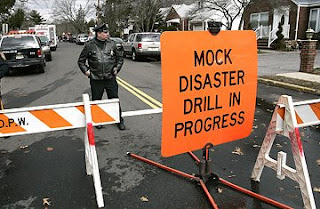In a memo to FEMA Administrator Craig Fugate this week, DHS Secretary Janet Napolitano ordered a “two-year progressive national drilling program which increases the total number of exercises and culminates in a full-scale, biennial intergovernmental National Level Exercise (NLE).”
Thanks to Bill Cumming for sending me the memo; he will be writing about it on his Vacation Lane Blog.
Though Napolitano’s memo has broad policy implications, I wanted to mention (due to the focus of this blog) a particular aspect — the involvement of the public in emergency drills which has been advocated by this blog. As the beginning of the memo, Napolitano writes:
A national exercise program must focus not only on the front lines of prevention, protection, response and recovery–our nation’s first responders-but also engage elected and appointed leadership at all levels of government, the public [my italics] and the private sector.
However, the rest of the memo does not mention any civilian involvement in the exercises. Though I would imagine that this will be worked out as the drilling program is fleshed out. As I have written extensively on the blog, I feel that including the public in these drills is useful both for the first responders and citizens.
Most every top national and local government preparedness official I’ve spoken to believes that preparedness drills for the public would increase citizen readiness and engagement. The difficulty of course is organizing these events. So, if the government is going to undertake major exercises, the opportunity should not be lost to involve the citizenry. Short of an actual incident, a drill is the best way to get people to think through what they would do if something actually happened. (Of course, the surprise or “no notice” drills might be difficult to integrate civilians who are not ordinarily on site but where possible citizens should be included.) It’s an issue that this blog will be following closely.
Napolitano’s memo comes in the context of a debate in the emergency management community about drilling policy as described in an article in April by the Washington Post’s Spencer Hsu:
The decisions are playing into a quiet debate about the future of the large-scale national exercises. Convinced that the drills are the best way to determine whether the nation is prepared for a disaster, some emergency planners and state officials say they fear that as the federal government cuts costs, it may dumb down the tests so participants will pass them more easily. Shying away from the toughest problems, they say, risks repeating the mistakes that were made after Hurricane Katrina, when an unprepared White House and Louisiana governor clashed over who was in charge, how to allocate resources and whether to send in the military.
White House officials and Homeland Security Secretary Janet Napolitano say they are trying to improve the national exercises, not undercut them. The drills have grown into unrealistic, costly and over-scripted productions, Napolitano has said, an “elaborate game” rather than opportunities for officials to work through problems.
In the memo, Napolitano asked FEMA’s Fugate to:
Develop a two-year progressive exercise program that increases the total number of exercises and culminates in a full-scale, biennial intergovernmental National Level Exercise (NLE). A progressive exercise program should consist of a series of much more frequent, smaller-scale drills, tabletops, and functional exercises, culminate in a single national level full-scale exercise…
Drills should be primarily no notice, or limited notice, and be conducted periodically during the two-year cycle by partners across DHS and the interagency, focusing on testing a single specific operation or function…
The capstone event ofthe progressive exercise program should be a full-scale intergovernmental National Level Exercise combining the elements and progressive lessons ofthe various drills, tabletops, and functional exercises into a multiday, intergovernmental exercise. This should combine the functional decision-making elements with actual ’boots-on-the-ground’ responders, with exercise elements driven by field actions rather than purely by scripted injects…
I understand that under the current National Exercise Program, NLEs are conducted every 12 months, and that much work and planning has gone into NLE11. Additionally, I believe it is important that a two-year progressive series build from exercise to exercise and function as a coherent, progressive whole, based on objectives and not simply scenarios. I further direct FEMA to conduct a cyber terrorism exercise as planned for NLE 12, and with the exception of the biennial nature of the culminating exercise, to adhere to the above principles in total. In the design of a National Exercise Program, FEMA should plan for the implementation ofa two-year progressive program to commence with the beginning of calendar year 2013.





1 response so far ↓
1 William R. Cumming // Aug 20, 2010 at 4:34 pm
It is of interest to me that the memorandum failed to mention the statutory mandates for exercises and lessons learned effort of the Post-Katrina Emergency Management Reform Act of 2006, Title VI of that years appropriations act. Hope to comparison the too sooner rather than later.
Leave a Comment